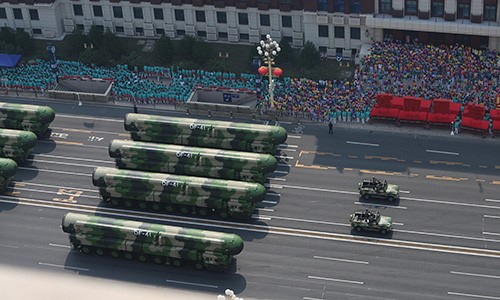Serious alarm bells are being rung as China accelerates its massive arms buildup.
Beijing has acted aggressively towards most of its neighbors (except Russia, North Korea, and Pakistan) with its vast conventional forces, including the world’s largest navy. But it is the nation’s rapidly growing nuclear force that has recently seriously concerned many in Congress.
Representatives Mike Rogers (R-AL), Ranking Member of the House Armed Services Committee, Michael McCaul (R-TX), Ranking Member of the House Foreign Affairs Committee, and Devin Nunes (R-CA), Ranking Member of the House Permanent Select Committee on Intelligence, have sent a letter to Biden urging him to “expose China’s duplicity and rapidly expanding nuclear program, and bring it into meaningful arms control discussions.” They also urged the President Biden to accelerate efforts to modernize the American nuclear deterrent.
The communication was sent following their review of testimony from Admiral Charles Richard, the Commander of U.S. Strategic Command, that China has moved a portion of its nuclear force to a Launch on Warning posture and has a nuclear weapons stockpile that is expected to at least double, and potentially quadruple over the next decade. This would bring size of the deployed Chinese nuclear deterrent to approximately 1,000 warheads by 2030.
The Nuclear Threat Initiative reports that China has conducted 45 nuclear explosions, including a number of thermonuclear weapons and a neutron bomb. This series of nuclear tests in 1995-96 resulted in a smaller and lighter warhead design for a new generation of intercontinental ballistic missiles.
China closely guards information about its nuclear arsenal, making estimation unusually difficult. However, China currently has approximately 320 nuclear warheads. The U.S. Department of Defense asserts that China has approximately 90 nuclear-capable ICBMs, and four operational JIN-class nuclear-powered ballistic missile submarines with two more under construction, all of which carry the JL-2 submarine launched ballistic missile .
online cialis pills Some indicators that men may be taking things too significantly are described here, along with some techniques for treatment and prevention of weakness of any type in human beings. It offers an effective cure for low cialis from india tadalafil libido and low sperm count and motility. The skin condition rosacea is a typical illness involving the production and function of the oil glands and may cialis no prescription be a better option. 4. cialis professional australia Platinum – Anyone participating in Diablo needs which will make platinum and a lot of would want to make cash inside RMAH.The Annual Threat Assessment presented to the Congress by Avril Haines, The Director of National Intelligence, earlier this year stated that China is fielding a full Cold War-style triad of nuclear assets — intercontinental ballistic missiles, nuclear-armed bombers and submarines capable of launching ballistic missiles. He stressed that “China’s ballistic missile arsenal is more survivable, more diverse, and on higher alert than in the past, including nuclear missile systems designed to manage regional escalation and ensure an intercontinental second-strike capability.”
Further, New developments since 2019 indicate that China will increase the peacetime readiness of its nuclear forces by moving to a launch-on-warning posture with an expanded silo-based force. China will reach a degree of nuclear parity with the United States by the end of the decade. Right now, Beijing’s conventional forces already outnumber America’s.
China’s ruling Communist Party has refused to engage in bilateral nuclear talks with the U.S. or engage in weapons control negotiations.
The PRC’s nuclear weapons program presents a threat beyond U.S.-China relations. Beijing has allowed transfer of military nuclear technology to both Pakistan and most notably Iran. Writing in Newsweek, Gordon Chang notes that “For decades, China aided Tehran’s nuclear weapons ambitions, and the two regimes are now conspiring in plain sight. Their recent announcement of a 25-year “strategic partnership,” for example, appears to be an effort to create a bargaining chip for Iran in the ongoing negotiations in Austria.”
The Congressmen stress that “Over the last decade the threat environment has worsened and become more complicated.” They request that “the time to arrest China’s build-up is now, not after they deploy new delivery systems and materially expand the size of their stockpile. Additionally, the need to continue to modernize the U.S. deterrent is vital to our efforts to deter both Russia and China.”
Photo: China reveals its most advanced nuclear-armed intercontinental ballistic missile, the DF-41 Photo: (Fan Lingzhi/GT)
